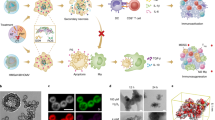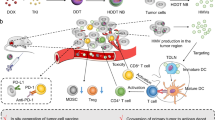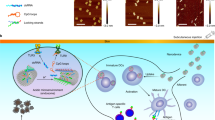Abstract
Therapeutic cancer vaccination is an attractive strategy because it induces T cells of the immune system to recognize and kill tumour cells in cancer patients. However, it remains difficult to generate large numbers of T cells that can recognize the antigens on cancer cells using conventional vaccine carrier systems1,2. Here we show that α-Al2O3 nanoparticles can act as an antigen carrier to reduce the amount of antigen required to activate T cells in vitro and in vivo. We found that α-Al2O3 nanoparticles delivered antigens to autophagosomes in dendritic cells, which then presented the antigens to T cells through autophagy. Immunization of mice with α-Al2O3 nanoparticles that are conjugated to either a model tumour antigen or autophagosomes derived from tumour cells resulted in tumour regression. These results suggest that α-Al2O3 nanoparticles may be a promising adjuvant in the development of therapeutic cancer vaccines.
This is a preview of subscription content, access via your institution
Access options
Subscribe to this journal
Receive 12 print issues and online access
$259.00 per year
only $21.58 per issue
Buy this article
- Purchase on Springer Link
- Instant access to full article PDF
Prices may be subject to local taxes which are calculated during checkout




Similar content being viewed by others
References
Pardoll, D. M. Cancer vaccines. Nature Med. 4, 525–531 (1998).
Finn, O. J. Cancer vaccines: between the idea and the reality. Nature Rev. Immunol. 3, 630–641 (2003).
Heath, W. R. & Carbone, F. R. Cross-presentation, dendritic cells, tolerance and immunity. Annu. Rev. Immunol. 19, 47–64 (2001).
Heijst, J. W. J. et al. Recruitment of antigen-specific CD8+ T cells in response to infection is markedly efficient. Science 325, 1265–1269 (2009).
Burgdorf, S. & Kurts, C. Endocytosis mechanisms and the cell biology of antigen-presentation. Curr. Opin. Immunol. 20, 89–95 (2008).
Vyas, J. M., Van der Veen, A. G. & Ploegh, H. L. The known unknowns of antigen processing and presentation. Nature Rev. Immunol. 8, 607–618 (2008).
Cresswell, P., Ackerman, A. L., Giodini, A., Peaper, D. R. & Wearsch, P. A. Mechanisms MHC class I restricted antigen processing and cross-presentation. Immunol. Rev. 207, 145–157 (2005).
Guy, B. The perfect mix: recent progress in adjuvant research. Nature Rev. Micro. 5, 505–517 (2007).
Pulendran, B. & Ahmed, R. Immunological mechanisms of vaccination. Nature Immunol. 12, 509–517 (2011).
Marrack, P., McKee, A. S. & Munks, M. W. Towards an understanding of the adjuvant action of aluminium. Nature Rev. Immunol. 9, 287–293 (2009).
Coffman, R. L., Sher, A. & Seder, R. A. Vaccine adjuvants: putting innate immunity to work. Immunity 33, 492–503 (2010).
Hermanson, G. T. Bioconjugate Techniques 2nd edn, 1202 (Academic Press, 2008).
Matteoni, R. & Kreis, T. E. Translocation and clustering of endosomes and lysosomes depends on microtubules. J. Cell Biol. 105, 1253–1265 (1987).
Porgador, A., Yewdell, J. W., Deng, Y., Bennink, J. R. & Germain, R. N. Localization, quantitation, and in situ detection of specific peptide-MHC class I complexes using a monoclonal antibody. Immunity 6, 715–726 (1997).
Regnault, A. et al. Fcγ receptor-mediated induction of dendritic cell maturation and major histocompatibility complex class I-restricted antigen presentation after immune complex internalization. J. Exp. Med. 189, 371–380 (1999).
Kratzer, R., Mauvais, F. X., Burgevin, A., Barilleau, E. & van Endert, P. Fusion proteins for versatile antigen targeting to cell surface receptors reveal differential capacity to prime immune responses. J. Immunol. 184, 6855–6864 (2010).
Reddy, S. T. et al. Exploiting lymphatic transport and complement activation in nanoparticle vaccines. Nature Biotechnol. 25, 1159–1164 (2007).
Pelka, K. & Latz, E. Getting closer to the dirty little secret. Immunity 34, 455–458 (2011).
Flach, T. L. et al. Alum interaction with dendritic cell membrane lipids is essential for its adjuvanticity. Nature Med. 17, 479–487 (2011).
Bjørkøy, G. et al. p62/SQSTM1 forms protein aggregates degraded by autophagy and has a protective effect on Huntington-induced cell death. J. Cell. Biol. 171. 603–614 (2005).
Kirkin, V., McEwan, D. G., Novak, I. & Dikic, I. A role for ubiquitin in selective autophagy. Mol. Cell. 34, 259–269 (2009).
Crotzer, V. L. & Blum, J. S. Autophagy and its role in MHC-mediated antigen presentation. J. Immunol. 182, 3335–3341 (2009).
Li, Y. H. et al. Efficient cross-presentation depends on autophagy in tumor cells. Cancer Res. 68, 6889–6895 (2008).
Uhl, M. et al. Autophagy within the antigen donor cell facilitates efficient antigen cross-priming of virus-specific CD8+ T cells. Cell. Death Differ. 16, 991–1005 (2009).
English, L. et al. Autophagy enhances the presentation of endogenous viral antigens on MHC class I molecules during HSV-1 infection. Nature Immunol. 10, 480–487 (2009).
Jagannath, C. et al. Autophagy enhances the efficacy of BCG vaccine by increasing peptide presentation in mouse dendritic cells. Nature Med. 15, 267–276 (2009).
Nishida, Y. et al. Discovery of Atg5/Atg7-independent alternative macroautophagy. Nature 461, 654–658 (2009).
Savina, A. et al. NOX2 controls phagosomal pH to regulate antigen processing during crosspresentation by dendritic cells. Cell 126, 205–218 (2006).
de Gruijl, T. D., van den Eertwegh, A. J. M., Pinedo, H. M. & Scheper, R. J. Whole-cell cancer vaccination: from autologous to allogeneic tumor- and dendritic cell-based vaccines. Cancer Immunol. Immunother. 57, 1569–1577 (2008).
Jensen, S. M. et al. Signaling through OX40 enhances antitumor immunity. Semin. Oncol. 37, 524–532 (2010).
Acknowledgements
The authors thank W. J. Urba for critical reading of the manuscript and Y. Zhang, P. Pang and M. Eastman for help with the collection of experimental data. Thanks also go to N. Morris and A. D. Weinberg for providing the anti-OX40 antibody. This research is supported in part by the Safeway Foundation and Providence Portland Medical Foundation (H-M.H.), Oregon Nanoscience and Microtechnologies Institute (J.J. and H-M.H.), the National Science Foundation (J.J.) and the National Institutes of Health (R01CA107243 and R21CA141278 to H-M.H.).
Author information
Authors and Affiliations
Contributions
H.L. performed the experiments and wrote the manuscript. Y.L. performed some experiments. J.J. and H-M.H. directed this work and wrote the manuscript.
Corresponding authors
Ethics declarations
Competing interests
H.L., J.J. and H-M.H. have filed a patent application titled 'Alumina nanoparticle bioconjugates and methods of stimulating immune response using said bioconjugates'. Y.L. has no competing financial interests.
Supplementary information
Supplementary information
Supplementary information (PDF 1985 kb)
Rights and permissions
About this article
Cite this article
Li, H., Li, Y., Jiao, J. et al. Alpha-alumina nanoparticles induce efficient autophagy-dependent cross-presentation and potent antitumour response. Nature Nanotech 6, 645–650 (2011). https://doi.org/10.1038/nnano.2011.153
Received:
Accepted:
Published:
Issue Date:
DOI: https://doi.org/10.1038/nnano.2011.153
This article is cited by
-
De novo design of a novel AIE fluorescent probe tailored to autophagy visualization via pH manipulation
Biomaterials Research (2023)
-
Advances on the early cellular events occurring upon exposure of human macrophages to aluminum oxyhydroxide adjuvant
Scientific Reports (2023)
-
Self-adjuvanting cancer nanovaccines
Journal of Nanobiotechnology (2022)
-
Recent advances in developing active targeting and multi-functional drug delivery systems via bioorthogonal chemistry
Signal Transduction and Targeted Therapy (2022)
-
Nanoparticle elasticity affects systemic circulation lifetime by modulating adsorption of apolipoprotein A-I in corona formation
Nature Communications (2022)



